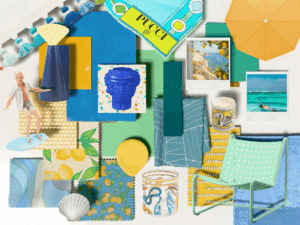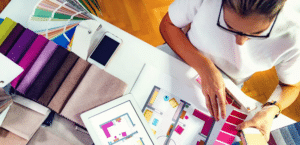This how-to guide will demonstrate how to render a furniture plan.
How to render drawings – part 5 of 6
Rendering a furniture plan
Whilst rendering this furniture plan, you will be representing different finishes and patterns using a range of colours.
In this concept, we have chosen a light, honey coloured, polished oak floor. Start by selecting a range of chalk pastels and then using a scalpel and then shave off enough of the chalk powder to be able to blend the exact colour. You will need to mask off all pieces of furniture before colour can be added to the floor. Using a cotton wool ball apply a base colour all over the floor to start off with and then build up the depth of colour by adding layers.
You need to consider how light and shade will appear within the room. The further away the window and in the corners of the room, the floor will appear much darker. To define the individual planks, use a ruler and a sharpened watercolour pencil in a darker shade. Additional lines can be introduced to represent the different lengths of the floorboards.
Once the lines have been added, you can go back and using the same pre-blended pastel chalks and a cotton bud, start to build up more depths of colour to represent each of the planks. Using a cotton wool ball, this same colour can now be used as a base colour for the rug.
Remove the post-it notes from around the furniture and fill in any gaps. The rug that has been selected has a deep textured pile in varying tones. Choose 2 or 3 watercolour pencils in suitable shades. This can be a little time consuming, but using the pencils individually, apply small dashed lines all over the area of the rug to represent the textures of the pile.
You’ll notice that in the centre of the rug between the 2 sofas is a white circle. This is representing a high gloss, white, contemporary coffee table. Therefore, colour does not need to be added to this area at the moment.
Once you are happy with the overall look, use a fine, damp brush to soften the effect and bring out the colours.
Within this room we have selected 2 different styles of sofas; upholstered with different finishes. The first sofa is upholstered with a light tan distressed leather. Start by selecting and mixing an appropriate colour using pastel chalks and apply this all over the sofa using a cotton bud.
To achieve the appropriate depth of colour you will need to apply a number of layers that have been blended. As this sofa is located on the far side of the room, you will need to think about how shadows will appear towards the back of the seat and near the arms. Towards the front of the seat cushions, the leather will appear much lighter and have a slight sheen to it. To represent this use a small part of the putty rubber and use a dabbing technique to lift off some of the colour, to show how the light is reflecting off of the leather.
For the second sofa, this has been upholstered in a multi-coloured, striped, wool mix fabric. If you look closely at the fabric, you will see that the main colour is predominantly a greyish-brown with the woven stripe of pink, orange and purple.
Start by mixing and applying the base colour all over the sofa, gradually building up the layers. Don’t forget to protect your drawing and keep this clean by placing a piece of paper over the top. It is much easier, if that this stage, you add in any areas of shadow towards the back of the seats and on the inside of the arms. You may find it easier to turn the paper when drawing in these details.
Select a range of watercolour pencils in pink, orange and purple and make sure these are sharpened so you can achieve a nicely defined stripe. Single lines will be enough to represent the design as the scale of the pattern will be much smaller. When adding these details, think about how the sofa is made up of different sections, these will include the seat cushions, arms and back cushions.
Start with the seat cushions and the arms and draw in the arms and then move on to the back cushions. Although the patterns should be matched, this should not be drawn as a continuous lines. Repeat this technique using the 3 different coloured water pencils to represent the pink, the orange and the purple stripes. Now use a damp brush to soften the lines, but more importantly help to intensify and define the colours.
Now the upholstery details have been added to both sofas, you can get a better understanding of how the drawing is coming to life and representing the concept. More shading can now be added to the floor where the furniture has been positioned. Shadows would naturally appear in-front of the sofas on the rug but also around the side and back of the leather sofa.
You may also want to add more depth of colour in the corners of the room, especially behind the door. The coffee table in the centre of the rug and the storage unit positioned to the right of the door both have a white, high gloss finish. The white of the paper is used to reflect this, but firstly you may need to use the putty rubber to clean inside the lines and remove any unwanted pastel smudges that may have appeared. A small amount of grey can now be added to show shadows and then the putty rubber can be dragged across to show the reflective surfaces.
Now that you have understood how to add colour to a furniture layout, the next video in this series will show you how to render the wall elevation.


One Response
very good easy to understanding great video